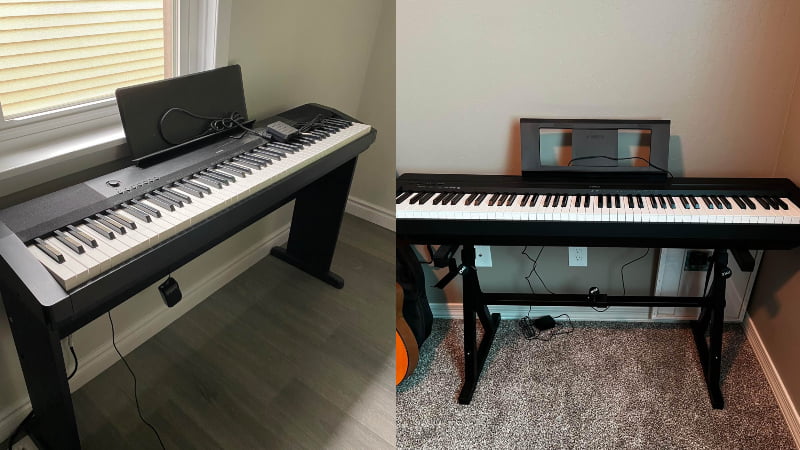When I tested out these two pianos for this Yamaha P71 vs Casio CDP-S150 comparison, it was hard to decide on a winner. Both pianos offered great features and tones that would be great for any beginner pianist. However, after a close battle, the Casio CDP-S150 narrowly edged out the Yamaha P71.
The Casio CDP-S150 was the better piano in my eyes because of a superior feel, portability, and a bunch of extra piano features that would be great for any beginner. The Casio CDP-S150 offers everything you’ll need when learning the instrument, though it was lacking when it came to tone.
And while the Yamaha P71 doesn’t have as good a feel or a varied set of features like the CDP-S150, it does have an incredible tone and decent sound system which could be the difference maker for some pianists.
Yamaha P71 vs Casio CDP-S150: Comparison Chart


Last update on 2025-04-07 / Affiliate links / Images from Amazon Product Advertising API
Yamaha P71 vs Casio CDP-S150: Differences
When trying to find the better option between the two, I figured the best way was to compare their features with each other. Both of these pianos come with great features, especially for beginners, but in the end, the Casio CDP-S150 narrowly edged out the Yamaha P71 by 3-2. It was a very close fight as both pianos have a lot to offer, which is why they are largely considered the best entry-level options in the game.
Feel
The winner: Casio CDP-S150
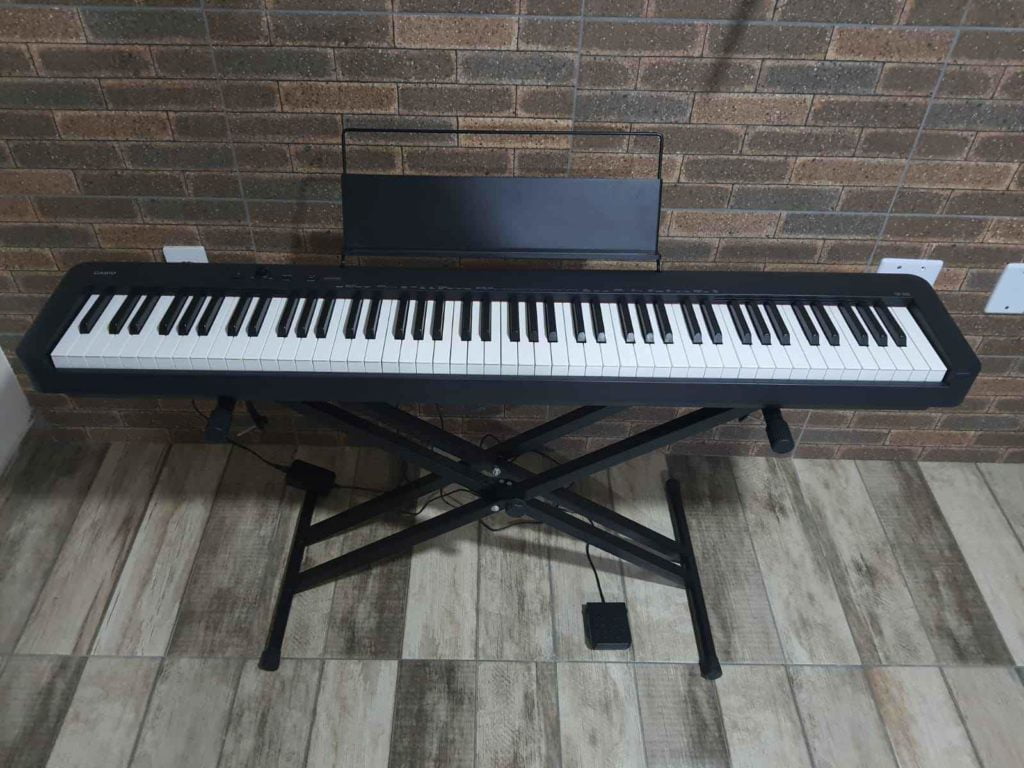
The first aspect where I found the Casio CDP-S150 to be the superior option is in the feel. Both pianos share similar hammer action, and the Yamaha P71’s is actually a bit heavier. However, the Casio CDP-S150 has a better key texture, which is why it was the clear winner in this regard.
Hammer Action
Both the Casio CDP-S150 and the Yamaha P71 use a variation of scaled hammer action. This is a process of making the lower keys on the left side heavier and the action gets progressively lighter as you move higher on the keyboard. This is used to simulate the feel of an actual acoustic piano, and both options do a fairly good job, especially considering their price.
And while the scaling of both pianos feels very accurate, it should be said that I noticed the CDP-S150 has slightly lighter action than the P71. This could be a good thing or bad thing, as different pianists have different hammer action preferences, but it’s still important to keep in mind.
Key Texture
This is the area where the CDP-S150 is a clear winner. This model sports plastic keys with a special coating to simulate the texture of ebony and ivory piano keys. This adds to the realism of the piano and can make a huge difference for experienced pianists playing more complicated pieces. Granted, this isn’t as important for beginner pianists, but as you get better at the instrument, it becomes more significant.
The Yamaha P71 sports plastic keys as well, however, they don’t have any coating at all. This is a major letdown as the keys really feel and look like plastic. Again, if you’re a beginner this is completely fine. However, as your pieces get more complicated and fast, you can feel the difference more and it could get in the way of your playing.
Tone
The winner: Yamaha P71
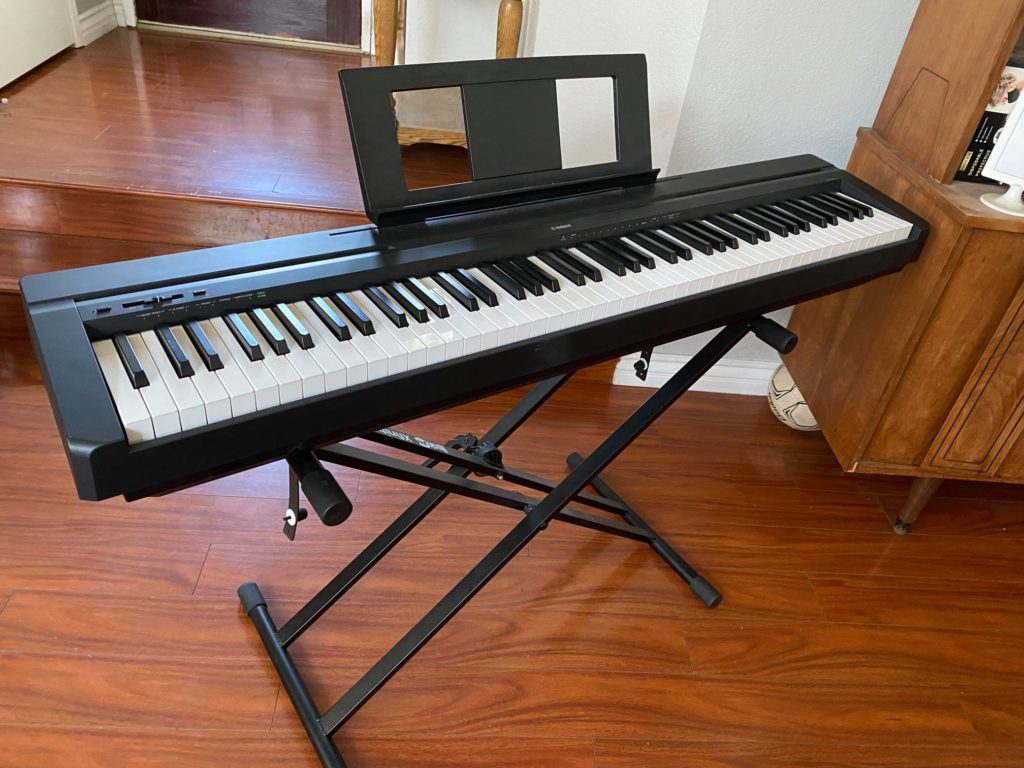
In terms of tone, the Yamaha P71 is a clear winner. The piano voices that come out of this instrument are very realistic, and many people claim that it’s the most realistic in its price range. When comparing the tone of these two pianos, I found the Yamaha P71 to have superior tone, though the Casio CDP-S150 was close behind.
Tone Generation
When doing my research, I couldn’t find any information on the exact tone generation method that the Casio CDP-S150 uses. The Yamaha P71 uses the AWM sampling method, and by the ear test, it was much crisper, brighter, and clearer than the CDP-S150.
Don’t get me wrong, the CDP-S150 has great piano tones that rival a lot of the best options in this price range. However, I found that the low end of the piano had pretty muddy tones, which can get in the way when playing fast pieces that use the entire keyboard. Additionally, the extra tones such as electric piano and harpsichord were lackluster, to say the least.
On the flip side, the Yamaha P71 had much crisper and clearer tones all throughout. Whether you use the grand piano, electric piano, or organ sounds, you’re ensured of very beautiful piano tones that give you a lot of versatility.
Sound Library
Both of these pianos have relatively simple sound libraries with 10 different tones each. This is far from a lot, but it’s about what is expected from a digital piano in this price range. Usually, with these pianos, you pay for the quality of the voice and not the quantity.
With that said, both pianos offer great ones that give you a lot of versatility. You have the freedom to experiment with a variety of acoustic piano, electric piano, bass, and even synth tones with these instruments, which is more than enough for a beginner.
Piano Features
The winner: Casio CDP-S150
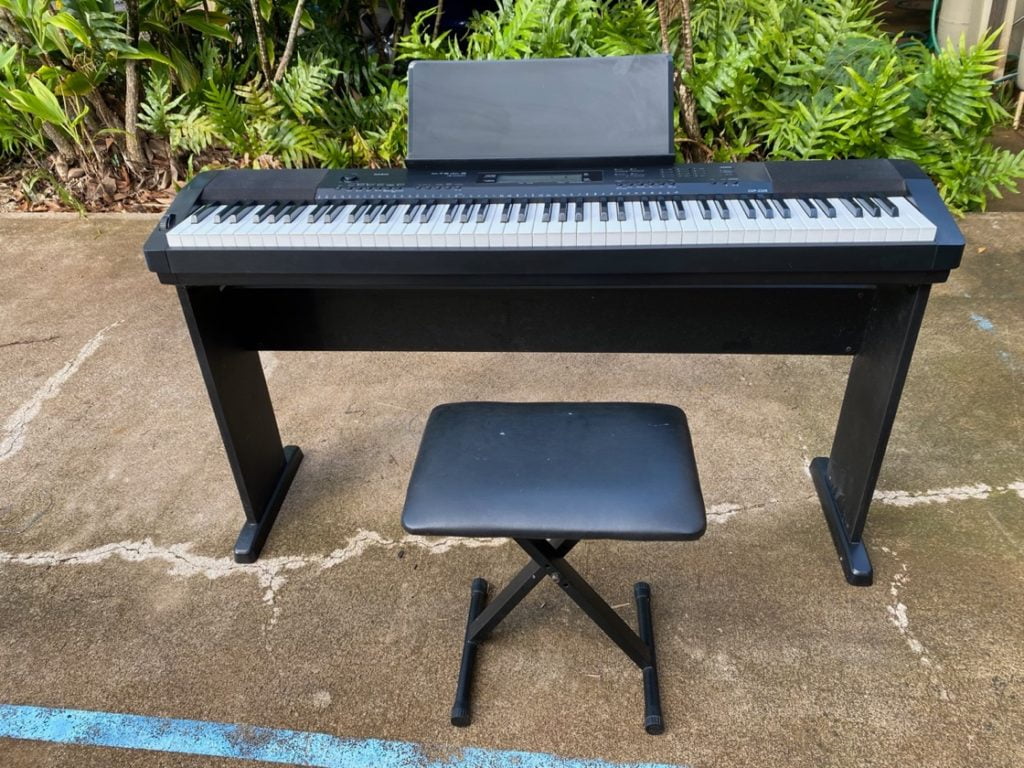
This area saw a very close battle between the two pianos, but the superior app integration and effects on the Casio CDP-S150 was the difference maker and the main reason I found it to be the better option between the two.
App Integration
While the Yamaha P71 is a very modern piano, it doesn’t integrate that well with apps, which is a feature you can find on other Yamaha pianos. On the other hand, the Casio CDP-S150 connects with the Cordana Play v2, which is available for iOS and Android phones. With the software, you can access tons of different features and playing modes that can supplement your learning.
Effects
Another reason I found the Casio CDP-S150 to be the better option is the wider range of effects. To start, you have 10 different reverb presets to play around with. You can give a lot of body and fullness to the piano tones, which can sometimes make up for the muddiness in the tone. However, it doesn’t stop there.
On top of the reverb effects, you also have access to a variety of chorus effects. You probably won’t use this effect too much for traditional classical music. However, chorus is a widely used piano effect in a lot of other genres such as pop, rock, blues, and even jazz!
With the Yamaha P71, you only have one effect: reverb. Granted, you can choose from 4 different types of reverb, which is better than most of the other options in this price range. With that said, it still can’t beat out the effects on the CDP-S150, which is why it lost in terms of the extra piano features.
Sound System
The winner: Yamaha P71
The sound system on the Casio CDP-S150 is a slight let down. It only has two 4.7W speakers which aren’t that loud. These speakers will be great for practicing alone, but you might find yourself having a hard time hearing the piano when jamming with other musicians. On top of that, these are rear-facing speakers, so it’s best to position this piano in front of a wall to get its full sonic potential.
The Yamaha P71 doesn’t have great speakers either, but they are arguably better than that on the CDP-S150. The Yamaha P71 has two, front-facing 6W speakers. These throws sound much better, especially towards the direction of the pianist, making it easier to hear yourself. While you won’t be able to use the speakers as monitors when playing with other musicians in front of a crowd, it’s definitely louder and crisper than the CDP-S150.
Portability
The winner: Casio CDP-S150
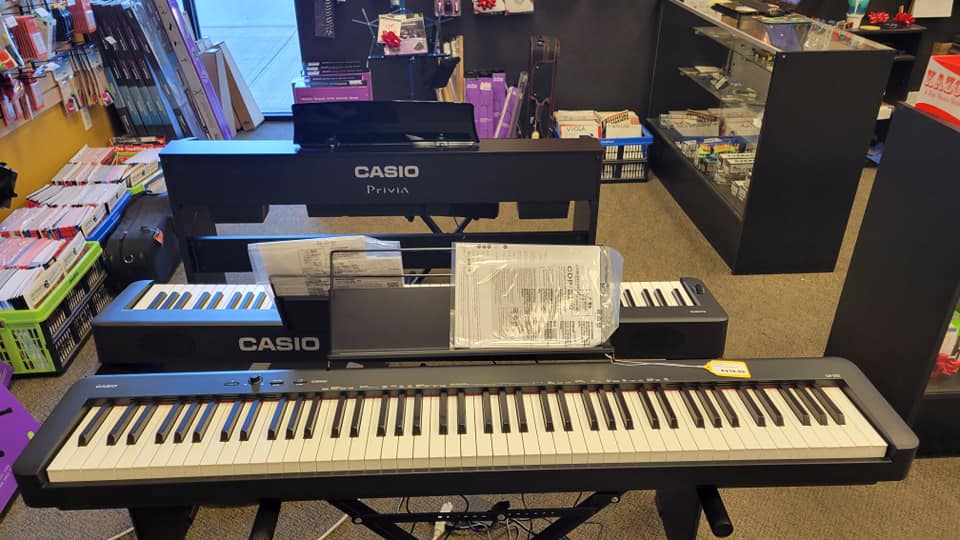
In terms of portability, the Casio CDP-S150 is the winner. This piano has one of the thinnest profiles and smallest carbon footprints among digital pianos. Not only does this help you live more sustainably, but it also results in a slim profile and a very light piano.
The CDP-S150 weighs around 23lbs, which makes it very easy to carry around. However, the main reason it’s such a portable instrument is because of its incredibly thin profile which allows it to easily fit in a car or bag. The Yamaha P71, on the other hand, is much thicker and heavier than the CDP-S150, weighing in at 25 lbs.
While it’s much easier to bring around the Casio CDP-S150, the Yamaha P71 is also a very portable option. Though if you get the Yamaha P71, expect it to be a bit heavier and bulkier than the Casio CDP-S150.
Yamaha P71 vs Casio CDP-S150: The Similarities
The Yamaha P71 and the Casio CDP-S150 both share a fair amount of similarities. For starters, they are both designed for the same type of pianist. Since these pianos lack some of the more premium features and are on the more affordable side, they are great beginner pianos. They both contain all the features you need when starting to learn an instrument, though as you get better, you might need to upgrade.
Both of these pianos have 64-note maximum polyphony. This is far from the most on the market, but it does give you enough freedom to play a lot of different music. Since it can play up to 64 notes at the same time, you won’t have a problem with wide and spread out chords. Though if you play multiple chords with the sustain pedal on a lot, then you might run into some trouble, which isn’t something beginners will find themselves doing too much, anyway.
Additionally, both these pianos have the same playing modes. You can access duo and dual mode on both instruments. Duo mode splits the piano into two evenly tuned mini-pianos. This feature is ideal for piano lessons as it allows the student and teacher to play along at the same time without needing to cross over their hands.
Dual mode is a unique feature. It blends the sound of two different voices, which makes for a very unique tone. This playing mode works great if you’re an accompanist or even playing solo. It offers a lot of versatility and room for experimentation, which are two important characteristics of a good beginner’s piano.
Quick Rundown of the Casio CDP-S150
- 88-key Scaled Hammer Action
- 64 notes polyphony
- 10 built-in tones
- Class Compliant USB MIDI
- Chordana Play App for Piano
Last update on 2025-04-07 / Affiliate links / Images from Amazon Product Advertising API
Quick Rundown of the Yamaha P71
- Acoustic Piano Feel - Touch-sensitive keys allow for true expression and dynamic performance. The weighted action replicates the acoustic piano experience
- Elevated Sound - Choose from 10 unique Voices, including the richness and resonance of a Yamaha grand piano, with full dynamic sound and deep bass
- Effortless Control - Simple one-button operation and streamlined functionality designed to keep you focused on your music
- Layered Sound - Dual Mode lets you blend two Voices, like piano and strings, creating a rich, layered sound for an inspiring new playing experience
- Included sustain pedal allows for subtle variations and greater expression in your performances
Last update on 2025-04-06 / Affiliate links / Images from Amazon Product Advertising API
Product Video
Related Articles to Casio Cdp S150
Related Articles to Yamaha P71
- Alesis Virtue Vs Yamaha P71: Can The Alesis Console Piano Beat Out The Amazon Exclusive?
- Yamaha P71 vs P95: Which Is The Better Digital Piano?
- Yamaha P71 vs Korg B2 Comparison: Battle Of the Two Top Beginner Pianos On the Market
- Yamaha P71 vs DGX-660: Can the Amazon Exclusive Beat Out the Premium Model?
- Yamaha P71 vs Donner DEP-20: Which Is the Best Beginner Piano?
- Yamaha P71 vs Casio PX-160 Comparison: Battle of the Two Best Digital Pianos on a Budget
- Yamaha P71 vs Alesis Recital: Why the Amazon Exclusive P71 Is the Best Option for Beginners
- Yamaha P71 vs Roland FP10 Review: A Tight-Knit Battle Where The FP10 Comes Out On Top
- Yamaha P71 vs Alesis Recital Pro: Which Digital Piano is the Best Option for Beginners?
- Yamaha P71 vs P125: Why the Yamaha P125 Is the Better Investment
- Yamaha P71 vs P45: Why the Amazon Exclusive P71 is the Better Digital Piano
References:
- Casio CDP-S150 Compact Digital Piano: https://www.sweetwater.com/store/detail/CDPS150–casio-cdp-s150-compact-digital-piano
- CDP-S150 Specifications: https://www.casio-intl.com/asia/en/emi/products/cdps150/spec/
Lulacruza is an electronic folk duo operating at the junction of the hypermodern and the ancient. Our music weaves together hypnotic female singing, South American folk instruments and electronic processing, while channeling pulsating waves from the source of creation.
Lalucruza is also a community where you can connect with other music lovers to collaborate, exchange ideas and share knowledge. A platform for who wants to learns the basics of playing piano, guitar, drum masters’ technique, etc.. is the premise of our website.
